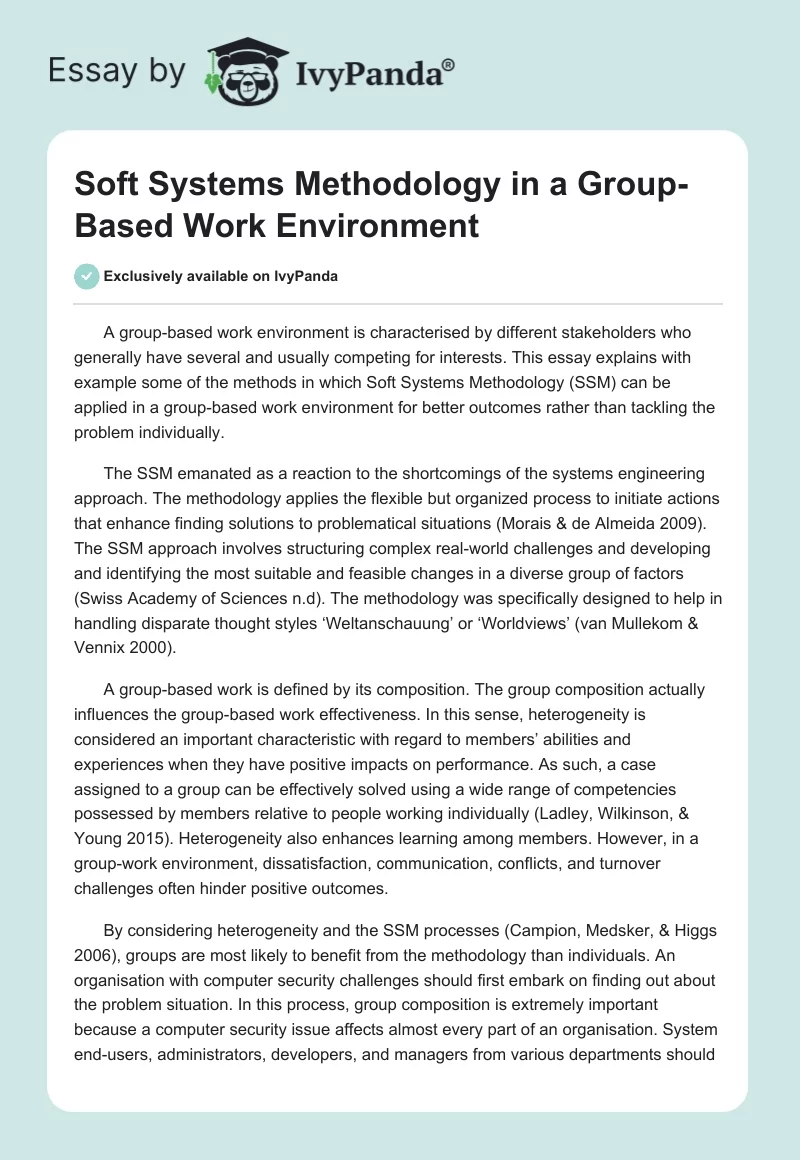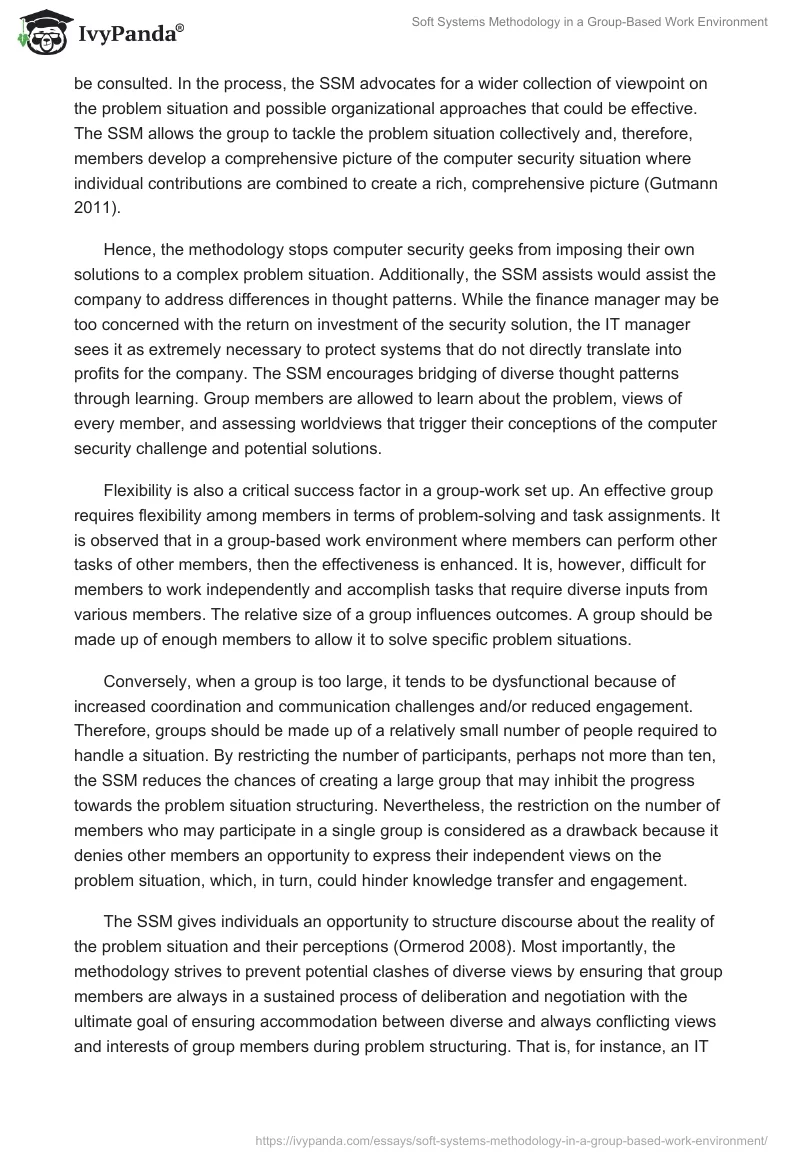A group-based work environment is characterised by different stakeholders who generally have several and usually competing for interests. This essay explains with example some of the methods in which Soft Systems Methodology (SSM) can be applied in a group-based work environment for better outcomes rather than tackling the problem individually.
The SSM emanated as a reaction to the shortcomings of the systems engineering approach. The methodology applies the flexible but organized process to initiate actions that enhance finding solutions to problematical situations (Morais & de Almeida 2009). The SSM approach involves structuring complex real-world challenges and developing and identifying the most suitable and feasible changes in a diverse group of factors (Swiss Academy of Sciences n.d). The methodology was specifically designed to help in handling disparate thought styles ‘Weltanschauung’ or ‘Worldviews’ (van Mullekom & Vennix 2000).
A group-based work is defined by its composition. The group composition actually influences the group-based work effectiveness. In this sense, heterogeneity is considered an important characteristic with regard to members’ abilities and experiences when they have positive impacts on performance. As such, a case assigned to a group can be effectively solved using a wide range of competencies possessed by members relative to people working individually (Ladley, Wilkinson, & Young 2015). Heterogeneity also enhances learning among members. However, in a group-work environment, dissatisfaction, communication, conflicts, and turnover challenges often hinder positive outcomes.
By considering heterogeneity and the SSM processes (Campion, Medsker, & Higgs 2006), groups are most likely to benefit from the methodology than individuals. An organisation with computer security challenges should first embark on finding out about the problem situation. In this process, group composition is extremely important because a computer security issue affects almost every part of an organisation. System end-users, administrators, developers, and managers from various departments should be consulted. In the process, the SSM advocates for a wider collection of viewpoint on the problem situation and possible organizational approaches that could be effective. The SSM allows the group to tackle the problem situation collectively and, therefore, members develop a comprehensive picture of the computer security situation where individual contributions are combined to create a rich, comprehensive picture (Gutmann 2011).
Hence, the methodology stops computer security geeks from imposing their own solutions to a complex problem situation. Additionally, the SSM assists would assist the company to address differences in thought patterns. While the finance manager may be too concerned with the return on investment of the security solution, the IT manager sees it as extremely necessary to protect systems that do not directly translate into profits for the company. The SSM encourages bridging of diverse thought patterns through learning. Group members are allowed to learn about the problem, views of every member, and assessing worldviews that trigger their conceptions of the computer security challenge and potential solutions.
Flexibility is also a critical success factor in a group-work set up. An effective group requires flexibility among members in terms of problem-solving and task assignments. It is observed that in a group-based work environment where members can perform other tasks of other members, then the effectiveness is enhanced. It is, however, difficult for members to work independently and accomplish tasks that require diverse inputs from various members. The relative size of a group influences outcomes. A group should be made up of enough members to allow it to solve specific problem situations.
Conversely, when a group is too large, it tends to be dysfunctional because of increased coordination and communication challenges and/or reduced engagement. Therefore, groups should be made up of a relatively small number of people required to handle a situation. By restricting the number of participants, perhaps not more than ten, the SSM reduces the chances of creating a large group that may inhibit the progress towards the problem situation structuring. Nevertheless, the restriction on the number of members who may participate in a single group is considered as a drawback because it denies other members an opportunity to express their independent views on the problem situation, which, in turn, could hinder knowledge transfer and engagement.
The SSM gives individuals an opportunity to structure discourse about the reality of the problem situation and their perceptions (Ormerod 2008). Most importantly, the methodology strives to prevent potential clashes of diverse views by ensuring that group members are always in a sustained process of deliberation and negotiation with the ultimate goal of ensuring accommodation between diverse and always conflicting views and interests of group members during problem structuring. That is, for instance, an IT expert would engage the finance to manage to explain why an organisation should invest in the robust computer security system (van Mullekom & Vennix 2000).
As previously noted, a group-based work environment is characterised by conflicts. On this note, the SSM provides a collaborative problem structuring to ensure problem situation objectives are addressed adequately. Given diverse interests, for instance, the IT department would want a robust, modern security system, the finance department, on the other hand, might consider such an investment irrelevant because it is difficult to explain its contributions to the margins. These interests imply that the goal itself is also a problem. Nevertheless, the group must work together to find solutions that alleviate the problem situation. Hence, the SSM advocates for a neutral person to head the problem structuring process by assisting the group to structure the problem and develop its own solutions.
Compared to working individually on a complex problem situation, robust solutions may not be readily available and the approach may fail to account for all actors and owners, but the SSM requires that such stakeholders be included in the problem-solving process. Given the collaborative nature of the SSM, the group is most likely to improve on the problem situation and motive other members to participate and implement the desired solutions. Group learning, which is not a component of individually based work, takes place while best solutions are created (van Mullekom & Vennix 2000).
It is imperative to appreciate that IT security issues, for instance, are complex challenges for many organisations. The SSM for group-based work enhances understanding of a complex problem through transparent, comprehensive processes (Kotiadis 2007), which may lack in cases undertaken by persons working individually. Moreover, SSM stresses the importance of defining and executing the required action with the goal promoting desirable and culturally realistic solutions. That is, changes must appeal to all stakeholders in the problem situation, considering their diverse traits and worldviews (Proches & Bodhanya 2015). For group-based work compared to individually undertaken work, the outcome could be different. That is, the SSM results tend to be realistic, practical, well-reflected, and preferred systems of actions that clearly demonstrate how problem situation can be improved (Checkland & Poulter 2006).
For a group-based work in which there are interdependent elements, working to attain different goals, and stakeholders have different viewpoints on challenges facing an organisation, thereby increasing the problem situation complexity, the SSM offers a robust, flexible, action-driven, and organised approach to improve problem situation of an organisation.
Reference List
Campion, MA, Medsker, G & Higgs, AC 2006, ‘Relations between work group characteristics and effectiveness: implications for designing effective work groups’, Personnel Psychology, vol. 46, no. 4, pp. Web.
Checkland, P & Poulter, J 2006, Learning for action: a short definitive account of Soft Systems Methodology and its use for practitioners, teachers and students, Wiley, Chichester, UK.
Gutmann, P 2011, Applying problem-structuring methods to problems in computer security, Web.
Kotiadis, K 2007, ‘Using soft systems methodology to determine the simulation study objectives’, Journal of Simulation, vol. 1, pp. 215–222. Web.
Ladley, D, Wilkinson, I & Young, L 2015, ‘The impact of individual versus group rewards on work group performance and cooperation: a computational social science approach’, Journal of Business Research, vol. 68, no. 11, pp. 2412–2425. Web.
Morais, DC & de Almeida, AT 2009, ‘Integrated model of problem structuring and multicriteria group decision making for social sustainable development’, Brazilian Journal of Operations & Production Management, vol. 6, no. 2, pp. 27-49.
Ormerod, R 2008, ‘OR and systems – some comments on Checkland’s reply to Eden and Ackerman’, Journal of the Operational Research Society, vol. 59, no. 1, pp. 139-142. Web.
Proches, CNG & Bodhanya, S 2015, ‘An application of Soft Systems Methodology in the sugar industry’, International Journal of Qualitative Methods, vol. 14, pp. 318-333.
Swiss Academy of Sciences, n.d. Soft Systems Methodology, Web.
van Mullekom, T & Vennix, JA 2000, Structuring managerial problem situations: assessing the suitability of different methodologies, Web.


